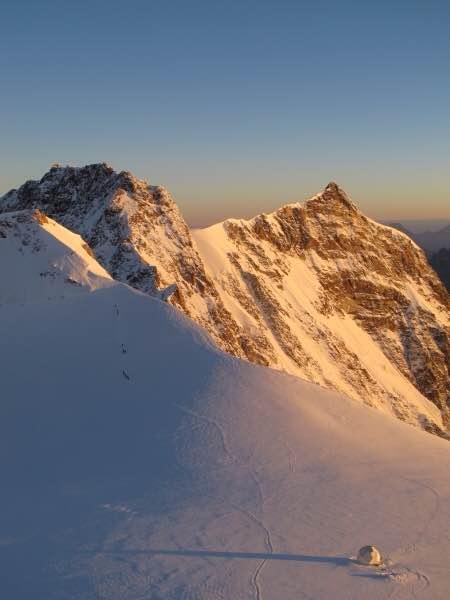
With generous support from:

A joint venture of the Climate Change Institute at the University of Maine and the Initiative for the Science of the Human Past retrieved a 73-meter (240ft) ice core from the Colle Gnifetti glacier in the Swiss Alps. Analysis of the ice core, at the Climate Change Institute, is producing invaluable new data about climate change and human-climate interactions from the last ca. 2,000 years. Concurrently, Harvard historians are combing pre-industrial written records to create a new geo-database of climate events, which complements the scientific data. The combination of the highest-resolution ice-core record in existence with the most comprehensive collection of pre-modern written records of weather anomalies is allowing scholars, for the first time, to trace climate, pollution and economic trends over millennia, on a sub-annual scale.
Methodology
Step 1: Planning and identification of a suitable site to retrieve an Alpine ice core featuring both unmatched proximity to population centers for the last 5000 years of human history and also ideal glaciological conditions that would permit identification of annual ice layers.
Step 2: Retrieval of 72-meter ice core from Colle Gnifetti, Monte Rosa (4450 meters above sea level), through an expedition organized by the Climate Change Institute at the University of Maine, Institut für Umweltphysik, Universität Heidelberg, and the Climate and Environmental Physics Institute, University of Bern.

Step 3: Preparation, inventorying and preservation of ice core samples for archive.
Step 4: Computerized Axial Tomography of every section of the ice core.
Step 5: Analysis of discrete ice samples via Inductively Coupled Plasma Mass Spectrometry (ICP-MS) establishing a 2000-year record using established technology at High Resolution.
Step 6: Analysis of ice core by next-generation Laser Ablation Inductively Coupled Plasma Mass Spectrometry, using the Climate Change Institute's W.M. Keck Laser Ice Facility, the only one of its kind in the world. The procedure takes microscopic samples via laser ablation, thus allowing the preservation of the ice core for future analysis, contrary to previous, lower-resolution methodologies which destroyed the ice. This analysis at this step produced a 2000-year, ultra-high-resolution, continuous calcium (Ca) deposition record from Colle Gnifetti. Detailed design and operation of this instrument were published by Dr. Sharon Sneed (New LA-ICP-MS cryocell and calibration technique for sub-millimeter analysis of ice cores, Journal of Glaciology, 61.226, 233-242 (2015) doi: 10.3189/2015JoG14J139).
Dr. Nicole Spaulding describing the functioning of the W.M. Keck Laser Ice Facility at the Climate Change Institute, University of Maine.
Step 7: Identification and counting of ice layers through analysis of the LA-ICP-MS calcium (Ca) record, a standard procedure in dating and creation of an ice-core chronology. Calcium layers are associated with yearly influx of Saharan dust during the summer season, as documented in all literature pertaining to this site and in our publication: Bohleber et al., "Temperature and mineral dust variability recorded in two low-accumulation Alpine ice cores over the last millennium," Climate of the Past, 14, 21-37 (2018), https://doi.org/10.5194/cp-14-21-2018
Step 8: Radiocarbon dating of particulate organic carbon fraction in the Colle Gnifetti ice core by Dr. Helene Hoffmann, at University of Heidelberg, produced and found to be in agreement with layer-counting chronology. See H. Hoffmann, "Micro radiocarbon dating of the particulate organic carbon fraction in Alpine glacier ice: method refinement, critical evaluation and dating applications," Ph.D. dissertation, University of Heidelberg, Germany, 2016.
Step 9: Creation of a geographically referenced database (geo-database) of historical records of weather observations for the pre-modern period, through consultation of compendia as well as original sources (first version published here, with updates published here). Compendia used include:
- Alexandre, P. 1987. Le Climat en Europe au moyen age: Contribution à l'histoire des variations climatiques de 1000 à 1425, d'après les sources narratives de l'Europe occidentale, (Paris: Éditions de l'École des Hautes Études en Sciences Sociales).
- Buisman, J. 1995-. Duizend Jaar Weer, Wind en Water in de Lage Landen. Vols. 1-3, of 6. (Franeker : Van Wijnen).
- Weikinn, C. Börngen, M. Tetzlaff, G. 1958-. Quellentexte zur Witterungsgeschichte Europas von der Zeitwende bis zum Jahr 1850. Vols. 1-3, of 4. (Berlin: Gebrüder Borntraeger).
- Teleles, I. 2004. Μετεωρολογικά φαινόμενα και κλίμα στο Βυζάντιο. 2 vols. (Athens, Ακαδημία Αθηνών).
Step 10: Ongoing measurements, analysis and comparison of glaciochemical record with historical records by SoHP-CCI team: public presentations of preliminary results.
Step 11: Ongoing analysis of high- and ultra-high resolution (ICP-MS and LA-ICP-MS) glaciochemical record of anthropogenic elements and identification of significant outliers. Focus on lead (Pb) as an initial proxy of pollution and economic activity.
Step 12: Creation of geographically referenced database of archaeological and historical evidence of lead (Pb) mining, trade and production in European sites in centuries where significant anomalies occurred. Comparison with a geographically referenced database of European pandemics in the last millennium, with special focus on arrival dates in areas of lead (Pb) production (databases published in More et al., "Next Generation Ice Core Technology Reveals True Minimum Natural Levels of Lead (Pb) in the Atmosphere: Insights from the Black Death," GeoHealth (AGU), 1, 211-219 (2017) (DOI: 10.1002/2017GH000064).
Step 13: Comparison of high- and ultra-high-resolution glaciochemical record of lead (Pb) deposition at Colle Gnifetti with archaeological and historical record. Identification of lowest level of lead (Pb) pollution in concomitance with the largest pandemic that ever ravaged Eurasia, the Black Death, 1348-53 C.E.
Step 14: Analysis of high-resolution glaciochemical record as well as historical geodatabase of climate events for possible climate anomalies in concomitance with the 1348-53 C.E. period of low lead (Pb) pollution, which may have affected deposition at Colle Gnifetti. No anomalies were found. Publication of first historical-archaeological-glaciochemical interdisciplinary study: More et al., "Next Generation Ice Core Technology Reveals True Minimum Natural Levels of Lead (Pb) in the Atmosphere: Insights from the Black Death," GeoHealth (AGU), 1, 211-219 (2017) (DOI: 10.1002/2017GH000064).
Step 15: Refinement of ice-core chronology with identification of a volcanic tephra marker trapped in the ice core, the first Icelandic tephra ever found in a European ice core, as published in Luongo et al., Possible Icelandic Tephra Found in European Colle Gnifetti Glacier, G-Cubed (AGU), 18.11 (2017) (DOI: 10.1002/2017GC007022)
Step 16: Refinement of ice-core chronology via comparison with calcium (Ca) layers in another nearby Colle Gnifetti core, and creation of a temperature proxy record via oxygen isotope analysis, as published in Bohleber et al., "Temperature and mineral dust variability recorded in two low-accumulation Alpine ice cores over the last millennium," Climate of the Past, 14, 21-37 (2018), https://doi.org/10.5194/cp-14-21-2018
Step 17: Publication of detailed discussion of interdisciplinary methodology in More et al., "The role of historical context in understanding past climate, pollution and health data in trans-disciplinary studies," GeoHealth (AGU), 2, 162-170 (2018), DOI:10.1029/2017GH000121.
Step 18: Refinement of ice-core chronology with additional volcanic tephra marker associated with the 536 C.E. eruption, as published in Loveluck et al., "Alpine ice-core evidence for the transformation of the European monetary system, AD 640 670," Antiquity 2018 https://doi.org/10.15184/aqy.2018.110
and in Ann Gibbons, "Why 536AD was the Worst Year to Be Alive," Science 11/14/18.
Prof. Paul Mayewski (Climate Change Institute) describing the above methodology in detail at public presentation, Harvard University, November 14, 2018.
Full video of the first public presentation of preliminary results from the project, with detailed explanation of the methodology by Dr. Nicole Spaulding and Prof. Paul Mayewski, November 15, 2015.
For specific methodological questions not addressed by the above description, linked publications and presentations, please contact: icehistory-group@maine.edu
Acknowledgements:
Recovery and analysis of the CG ice core, associated written records, and interpretation were supported by the Arcadia Fund of London (AC3450; AC3862; AC4190). All ICP-MS and LA-ICP-MS analyses were conducted in the Climate Change Institute’s W. M. Keck Laser Ice Facility and their ICP-MS laboratory at the University of Maine. We gratefully acknowledge support for this facility from the W. M. Keck Foundation and the National Science Foundation (PLR- 1042883 and PLR-1203640). All written historical records discussed here were collected and analyzed by the Initiative for the Science of the Human Past at Harvard University. Financial support was provided to P.B. by the Deutsche Forschungsgemeinschaft (BO 4246/1-1).
The CG ice core was collected by a joint team effort from Institut für Umweltphysik, Universität Heidelberg, CCI at the University of Maine and the Climate and Environmental Physics Institute, University of Bern. We acknowledge the generosity of Dr. Hubertus Fischer, of the Climate and Environmental Physics Institute, University of Bern, in providing the drilling equipment. We particularly thank the drillers Remo Walther and Samuel Marending for their efforts during the drilling campaign. Additional support in ice core processing and analysis was provided by the Alfred- Wegener-Institute, Bremerhaven and the Climate and Environmental Physics Institute, University of Bern. We gratefully acknowledge their support.
We thank Matthew Luongo (Harvard College, ’17) and Jakub Kabala of Davidson College, both alumni of the Initiative for the Science for the Human Past at Harvard, for their work on the Geodatabase of European Climate from Written Sources. We would like to acknowledge especially our late colleague Dietmar Wagenbach (Heidelberg University) for his contributions at the early stage of our project and for sharing his unique expertise on ice core research at Colle Gnifetti.

